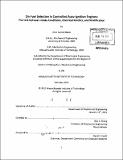On fuel selection in controlled auto-ignition engines : the link between intake conditions, chemical kinetics, and stratification
Author(s)
Maria, Amir Gamal
DownloadFull printable version (30.93Mb)
Other Contributors
Massachusetts Institute of Technology. Dept. of Mechanical Engineering.
Advisor
Wai K. Cheng.
Terms of use
Metadata
Show full item recordAbstract
The objective of this research is to examine the impact fuel selection can have on the high-load limit in a stratified Compression Auto-Ignition (CAI) engine. This was accomplished by first studying the validity of the current metrics that predict when the high-load limit is reached. Temperature and fuel concentration stratification, and the degree that they can be used to relax the constraint on the highload limit, were then examined. The effectiveness of stratification was then related to the chemical kinetic behavior of different fuels. The conclusions were then used to develop a fuel selection procedure for CAI engines. A modified Renault F9Q B800 common rail diesel engine, with a compression ratio of 19, and displaced volume of 467 cm3 per cylinder, was used to assess these goals. The chemical kinetic behavior of the fuels was obtained with a specially designed Rapid Compression Machine (RCM). It has been shown that the Ringing Index, a commonly used knock metric, does not perform well when stratification is present and sequential ignition occurs. The correlation that is used to approximate the pressure oscillation amplitude is not accurate in the presence of sequential ignition. A modified correlation for the pressure oscillation amplitude has been presented. It was found that the pressure oscillation amplitude can be reduced, at a given pressure rise rate, by increasing the combustion pressure, by increasing the combustion temperature, or by reducing the combustion length scale. With regards to fuel selection, a fuel that does not exhibit a large Negative Temperature Coefficient (NTC) region can extend the high-load limit by up to 20% when temperature stratification is present. The NTC region has minimal temperature sensitivity and would naturally reduce the effectiveness of temperature stratification. The presence of an NTC region is also dictated by intake conditions. A larger intake pressure tends to reduce the size of the NTC region, which leads to more temperature sensitivity in the chemical kinetic behavior of the fuel. As a result, both fuel selection and intake conditions must be considered when evaluating the effectiveness of stratification in a CAI engine.
Description
Thesis (Ph. D.)--Massachusetts Institute of Technology, Dept. of Mechanical Engineering, 2012. Cataloged from PDF version of thesis. Includes bibliographical references (p. 233-235).
Date issued
2012Department
Massachusetts Institute of Technology. Department of Mechanical EngineeringPublisher
Massachusetts Institute of Technology
Keywords
Mechanical Engineering.